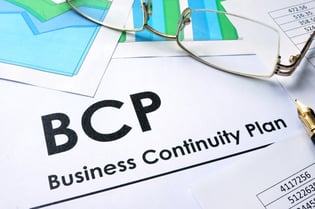
In our digital-dependent world, losing access to technology can cause financial hardship. The cost of IT downtime for a small business ranges from $137 to $427 per minute! It’s expensive if a disaster puts your business out of commission for a few hours or days.
Extreme weather isn’t the only threat to your data. Cyber attacks, system failures, and human error cause disasters, too. Is your business prepared if a disaster strikes? Do you have an IT disaster recovery plan in place to protect your business?
The right plan increases your ability to recover lost data. It means a return to normal operations in the least amount of time. Not having a plan puts your company’s survival at risk. According to FEMA, 40 percent of small businesses never reopen after a disaster.
You need a reliable plan in place before a disaster happens. Essential aspects of a successful disaster recovery plan include:
- Assessment and Planning
- Data Replication
- Documentation and Procedures
- Communication
Keep reading to learn how to build your IT disaster recovery plan.
Assess and Plan
Every disaster recovery plan should begin with an assessment. Look at your business needs and your budget. Determine how a disaster could affect the business and employees. This should include a close examination of people, technology, and facilities.
Identify what you want your disaster recovery plan to do. Ask the tough questions. How will you recover data? Technology? People? Look at redundancy across the company for staff and technology. Make plans for different scenarios.
Develop plans for every possible disaster. Each type should have its own action plan. This helps employees and potential contractors understand priorities following a disaster. Create written procedures for each scenario.
Once you have a plan, put it in writing and make sure everyone is familiar with it. Every employee should know how to respond to a disaster. Disaster recovery plans should be part of new and current employee training. Add the plan to company operations information.
Inventory Everything
It’s critical to inventory all technology including hardware and software. When you add equipment, software or hardware update your recovery plan.
Think beyond the tech. IT departments get hung up on plans to restore operational platforms. It’s vital to build a plan that prioritizes staff and processes. Employees must know what to expect in an emergency situation.
Disaster planning is hard for small businesses with one- or two-person IT departments. Look into managed service providers. They work with you to create custom disaster recovery plans.
Rank Threats
All disaster recovery plans should determine the likelihood of various threats. If you’re located in hurricane alley, hurricanes should top your list. No matter where your business is, plan for events like cyber attacks.
Consider which threats have the highest risk for your company. Analyze each situation and how your organization should react.
Data Redundancy
First, get organized. Know what data you have and where it’s located. Next, decide on the logistics of protecting it. Duplicate files by copying them from a primary location to a secondary one.
Will you replicate data at a physical site or with SaaS technology? It’s wise to back up your business data in several locations. Cloud providers offer instant access to critical data. They replicate your data in another region far from the primary location.
Establish a failover site. A failover means switching to a redundant or standby computer server or system. If your network goes down for any reason the system switches. A failover can be a computer server, system, hardware component or a network.
Choose a platform that lets staff operate as if there wasn’t a disaster. This means setting up cloud services and virtual desktop environments.
Consider whether employees will work from the backup location or remote from home. Security is an issue in both cases. Create secure access points.
Documentation and Procedures
Every recovery plan should include written instructions. Tell people what to do before, during, and after the disaster.
Decide on responsibilities for everyone from management to maintenance. Identify proactive measures. Plan responses to different crisis events. Create a checklist of recovery steps. Be clear about relocation options.
Break down the plan by department or business area. Address each aspect of your business. Loss of data effects:
- Administration
- Manufacturing
- Physical Plant
- Sales
- Marketing
- Communication
Each department needs a checklist of steps. Cover what happens at first alert, during, and after the crisis. The plan should relieve any concerns held by owners and stakeholders.
Reduce Response Time
A key part of every IT disaster recovery plan is response time. Can your IT team and other recovery team members mobilize fast? You only get one chance at a first response.
Clear, concise plans and trained staff are the best defense. Test your disaster response once or twice per year. Look for areas to improve. Make sure every employee understands the plan.
Plan Maintenance
Technology continues to evolve and change, inside and outside an organization. Update your disaster plan on a regular basis so it’s up to date.
Put routine risk assessments on your calendar. Ask the IT department review the recovery plan. Make sure it always addresses all risks.
Communication
A top priority for any disaster plan is to establish communication as soon as possible. It’s essential for the deployment of the recovery plan.
Make a list of people to notify first. Create an accurate and comprehensive contact list. Another option is a mass notification system. It can send texts or messages to personal devices.
Remember, if the company’s email server is down you’ll need another way to reach everyone.
Create Your IT Disaster Recovery Plan Today
When a disaster occurs, the goal is to resume operations as fast as possible. Your recovery plan presents solutions and reduces the risk to the company.
If your organization doesn’t have an IT disaster recovery plan it’s time to make one. Or, if you have an insufficient plan make revising it a priority. Avoid costly delays and damage by completing your plan now.
Put your disaster strategy in place. Think hard about goals, inventory, contingencies, and recovery resources. A solid, actionable plan is the difference between business survival or failure.
For guidance on the best plan for your business, contact the experts at LINC Project today.
Ludovic Levivier
Founder & CEO, LINC Project, INC. a Managed Service Provider in New York and San Francisco



.png?width=306&height=50&name=Logo_width.jpg(2).png)


